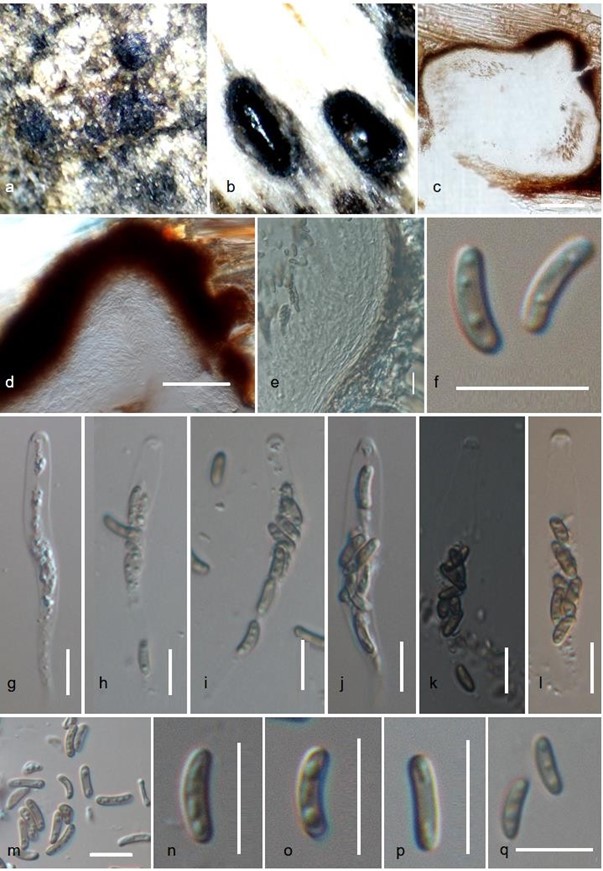Halocryptosphaeria bathurstensis (Dayarathne & K.D. Hyde) Dayarathne, Devadatha, V.V. Sarma & K.D. Hyde, comb. nov. Fig. 76
≡ Eutypa bathurstensis K.D. Hyde & Rappaz
MycoBank number: MB 556801; Index Fungorum number: IF 556801; Facesoffungi number: FoF 04597;
Saprobic on decaying wood of Avicennia marina. Sexual morph: Stromata extend up to 0.5–2 cm long, immersed, blackening the wood surface. Entostroma poorly developed, dorsally limited by a black zone binding the stromatic area. Ascomata 250–600 × 200–450 μm, (x̅ = 402 × 347 µm, n = 5), spherical to sub spherical, regularly spaced, submerged in the wood, occasionally deeply buried, long necked, raised, and blackening the wood surface. Ostiole up to 60–200 × 60–100 μm (x̅ = 142 × 80 µm, n = 5), poorly developed or conical, not sulcate. Peridium 10–30 μm (x̅ = 19 µm, n = 5), wide, comprising thin white line under the black hymenium, composed of three layers; a subhymenial layer of hyaline hyphae of textura globosa-angularis mixed with ascogenous elements, a middle layer comprising guttulate hyaline cells, forming a textura globosa, an outer most layer composed of melanized cells interdispersed with wood elements, wider near the ostiolar canal. Hamathecium lining the whole cavity. Paraphyses numerous, hyaline, aseptate, persistent. Asci 42–50 × 5–8 μm (x̅ = 46 × 6 μm, n = 10), 8-spored, clavate, J-, long pedicelate. Ascospores 5– 10 × 1–2.5 μm (x̅ = 8 × 1.5 μm, n = 30), olive-brown, aseptate, allantoid, guttulate. Asexual morph: Phomopsis like
Culture characteristics: – Ascospores germinating on seawater agar within 24 hours, germ tubes arising from both sides of the ascospores. Colonies on MEA with moderate growth, reaching 30–50 mm diameter after 15 days of incubation at room temperature, white to cream, reverse pale brown, cottony, surface undulate, irregular. Culture isolated from the single ascospore remained non-sporulating even after incubation at room temperature for one month.
Material examined: – INDIA, Tamil Nadu, Parangipettai mangroves (11.59°N 79.5°E), on decaying wood of Avicennia marina (Acanthaceae), 23 April 2016, B. Devadatha (AMH-9952, reference specimen designated here), living culture (NFCCI-4248).
GenBank numbers: – ITS: MN061366; BTUB: MN431496
Notes: – Halocryptosphaeria bathurstensis (≡Eutypa bathurstensis) collected from Parangipettai mangroves is morphologically similar to Halocryptosphaeria bathurstensis (≡Eutypa bathurstensis) reported by Hyde & Rappaz (1993). With strong morphological support we designate this specimen (AMH-9952) as a reference specimen for H. bathurstensis (sensu Ariyawansa et al. 2014) with the objective of providing the availability of a reliable herbarium material in good condition and corresponding molecular data for future studies. Eutypella naqsii resembles Halocryptosphaeria bathurstensis but clearly distinct in having small groups of ascomata and ascospores that are hyaline to pale yellow. Hence, a new combination Halocryptosphaeria bathurstensis has been introduced for Eutypa bathurstensis based on both morphological characteristics and its closer relationship in phylogenetic analysis with Cryptosphaeria by Dayarathe et al. (2019c). Halocryptosphaeria bathurstensis and H. avicenniae share identical morphological characteristics and overlapping dimensions of the ascomata and ascospores. However, H. bathurstensis is distinct from H. avicenniae in having longer necks, shorter asci bearing spore part and olive-brown ascospores. Furthermore, pairwise alignment comparison of ITS gene regions of H. bathurstensis and H. avicenniae resulted in a difference of 2.89% (out of 461 bp).

Figure 76 – Halocryptosphaeria bathurstensis (AMH–9952). a Ascomata erumpent, immersed in decaying wood of Avicennia marina. b Horizontal sections of ascoma. c Vertical section of ascoma. d Ostiole. e Peridium. g–l Immature and mature asci. f, m–q Ascospores. Scale bars: c = 100 μm, d = 50 μm, e–q = 5 μm.
